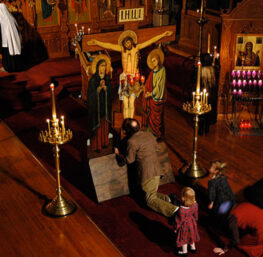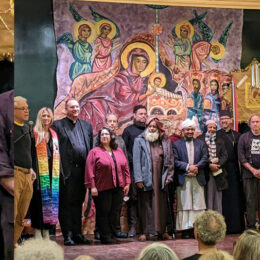Human Events | Robert H. Knight | Nov. 16, 2007
In contrast, a few hundred yards away in the circa 1699 Christopher Wren Building on the campus of William & Mary, a small brass cross that had graced the chapel’s altar, was now encased in … plastic. What had been a symbol of the ongoing importance of faith to America’s continued story was now officially a museum piece.
While the vets proudly marched nearby, the second oldest university in the nation (after Harvard) was officially dissing the faith that launched the American Revolution as — you guessed it — not inclusive enough.
The Wren cross was on its way to relic status in October 2006, when William & Mary President Gene R. Nichol had it removed following a complaint from a visiting prospective student. After an outcry from the campus community and alumni, Nichol responded in an Oct. 27 e-mail, which read in part:
Let me be clear. I have not banished the cross from the Wren Chapel. The Chapel, as you know, is used for religious ceremonies by members of all faiths. The cross will remain in the Chapel and be displayed on the altar at appropriate religious services.
But the Chapel is also used frequently for College events that are secular in nature–and should be open to students and staff of all beliefs. Whether celebrating our happiest moments, marking our greatest achievements, or finding solace during our most profound sadness, our Chapel, like our entire campus, must be welcoming to all.
Translated, this means that the cross must be banned if there is even a possibility of offense. As you can imagine, this did not put the matter to rest, so Nichol explained further, as recorded by the Richmond Times-Dispatch on Nov. 17, 2006:
The display of a Christian cross — the most potent symbol of my own religion in the heart of our most important building — sends an unmistakable message that the chapel belongs more fully to some of us than to others. That there are, at the college, insiders and outsiders. Those for whom our most revered place is meant to be keenly welcoming, and those for whom presence is only tolerated.
That distinction, I believe to be contrary to the best values of the college.
There are lots of foreign students at William & Mary. Wouldn’t it make sense, then, to remove all American flags from the campus lest they offend someone? Come to think of it, I don’t recall seeing any.
But back to the chapel. Let’s leave aside the absurdity of being embarrassed that a Christian chapel would sport a cross instead of a Buddha, a Muslim crescent, a Wiccan pentagram or a statue of Zeus. And let’s leave aside the fact that religious tolerance is a hallmark of Christian influence, unlike any other religion. Nichol justified his actions by appealing to universal tolerance:
… The Wren is no mere museum or artifact. It touches every student who enrolls at the college, It defines us. And it must define us all.
Nichol got religion, of sorts, apparently, when a donor in February yanked a $12 million gift to the university over the cross removal. For a few months, the cross was put on display on the altar on Sundays, then packed away during the week. Nichol refused to restore it to the altar permanently despite a petition with more than 12,000 signatories. He bravely said, “The core value of the college cannot be for sale.” And what’s that core value again? Oh, yes, “religious diversity.”
In February 2007, the university hosted a “Sex Worker Fair,” complete with strippers, sex toys and “erotic dances.” The Virginia Gazette reported this comment from Nichol when he was asked why this event was allowed on his campus.
“I don’t like this kind of show and I don’t like having it here,” he said. “But it’s not the practice and province of universities to censor or cancel performances because they are controversial.”
No, of course not. And the university officials knew what they were hosting, because it was the second straight year for the Sex Worker Fair.
On August 3, the cross was returned to Wren Chapel, but placed in a plastic box atop a wood base.
For the secularists at war with America’s traditional values, these are huge victories. Sex shows are in, Christianity is under glass. If you can treat Christianity as a relic, a bygone faith made obsolete by scientific materialism, you can reshape the world according to whatever the New Age wants. Which, apparently, is sex shows. As Chesterton observed, sex is the materialists’ religion.
What would those marching veterans have thought of all this? Most of them were probably blissfully unaware, since the media lost interest in the story back in August, when the cross went into the box.
But if secularists are celebrating, they should take heed. As much as it annoys them, Jesus wouldn’t stay in the Tomb. And neither will the power of His cross be contained by a glass box. Or one made of plastic.
. . . more




If I’m reading this correctly, it sounds like Knight is not disagreeing with this statement by Nichol. Rather, Knight agrees, but feels that is the way it ought to be. Knight is arguing that the status quo at William & Mary ought to be the message that Christianity is preferable to other religions.
Is that the interpretation that other readers get, or am I misunderstanding this piece?
Here’s something appropriate for that chapel:
Agnostic’s Prayer:
Insofar as I may be heard by anything, which may or may not care what I say, I ask, if it matters, that you be forgiven for anything you may have done or failed to do which requires forgiveness. Conversely, if not forgiveness but something else may be required to insure any possible benefit for which you may be eligible after the destruction of your body, I ask that this, whatever it may be, be granted or withheld, as the case may be, in such a manner as to insure your receiving said benefit. I ask this in my capacity as your elected intermediary between yourself and that which may not be yourself, but which may have an interest in the matter of your receiving as much as it is possible for you to receive of this thing, and which may in some way be influenced by this ceremony. Amen.
What do we revere and obey?
Something in the area of the groin.
From what I’ve read on the Wren chapel the policy used to be that the cross was on the altar unless requested to be removed, but the policy now is that it is removed from the altar unless requested to be put back on. Initially, it seems that the issue is whether the cross should be on the altar by default. But I think that the main issue is much more than that.
Interestingly the cross is still “on display” in the chapel. You can see it here:
http://www.wm.edu/news/?id=8021
“The case and cross are now located near the east door of the front of the chapel – an area along the north wall and near the rail that separates the chancel from the pews. The case also holds a plaque that commemorates the College’s Anglican roots and its historic connection to Bruton Parish Church. As determined by the committee in March, the cross now resides in the display case in the chapel when it is not being used on the altar for Christian religious services.” [Whenever those are.]
So if I understand this, when the cross is on the altar, it is potentially offensive. But when encased in plastic and displayed near the front door, it’s not offensive. But why would a mere change in location make that much difference? I think the key factor here is not the location, but the plastic case.
Why put it in a plastic case? it’s not going to fall over without one. It’s not like the building leaks and water is going to drip on the cross. So why a plastic case?
I think the only answer is that the plastic case turns the cross into an artifact, a display piece, something now only incidentally religious and primarily of historical interest. The president of the school is quoted as saying that a cross is “the most potent symbol” of Christianity, and that such a potent symbol should not be displayed in a chapel used by all. Yet we know that the cross still is displayed in the chapel. The function of the plastic case is to make it not potent, literally “impotent” – without religious significance. So the cross is still “on display,” but the plastic case ensures that it is an impotent cross, no longer able to inspire religious passion or faith, a harmless object, domesticated, neutered, now available for viewing in the Wren chapel. And perhaps that’s appropriate — and impotent cross for those of impotent faith.
This supports the notion that the anger in Knight’s piece, and the backlash to the president’s decision, is not over the “banning” or “banishment” of the cross, but over the message that is being sent.
Knight isn’t contradicting Nichol’s idea that the presence of the cross on the altar indicates that the chapel belongs more fully to some than others; rather, Knight believes the chapel _should_ belong more fully to some than others.
Knight says as much when he calls the chapel, which according to University policy ” is used for religious ceremonies by members of all faiths,” a Christian chapel. So while his piece purports to be about how the University is taken inappropriate measures to “offend” non-Christians, it’s really about Christian primacy: Chrsitianity is better than other religions, and the University should not take any steps to stop sending that message.
Phil writes: “This supports the notion that the anger in Knight’s piece, and the backlash to the president’s decision, is not over the “banning” or “banishment” of the cross, but over the message that is being sent.”
Yes, the cross has not been banished. I think from a Christian perspective it would be better if it were. Since the cross is still displayed, obviously the problem is not displaying the cross. The problem is that the cross has been changed into a kind of secular, historical object. (This is one reason why I don’t understand why some Christians want to have the Ten Commandments displayed in courthouses, under the pretext of being some kind of “historical” document. The Ten Commandments, written by God upon stone, each word, each letter filled with unfathomable spiritual meaning, turned into a history lesson? When I hear that advocated I think “is that really what you want?”)
Phil: “So while his piece purports to be about how the University is taken inappropriate measures to “offend” non-Christians, it’s really about Christian primacy: Chrsitianity is better than other religions, and the University should not take any steps to stop sending that message.”
To some extent, I have to disagree. People could already request that the cross be removed from the altar for specific occasions. E.g., a Jewish wedding did not have to have the cross displayed. It’s not about Christian primacy, but about what the chapel is — a chapel whose primary purpose is built into its very structure, with a particular orientation, an altar, and antiphonal seating. Is it primarily a Christian chapel that by the way can be used for other purposes, or is it primarily a nice-looking multi-purpose room that, by the way can be used for Christian worship? One can ask a similar question of the cross. Is it primarily a potent religious symbol that can be moved upon request for special occasions, or is it primarily an historical object that, by the way can be taken out of the plastic box and used for religious services?
The issue as I see it is not about the primacy of Christianity, but about the primacy of what the cross and the chapel are all about, and the religious tradition and history that created them and brought them together. It seems the university has answered that question from a secular point of view, and thereby made many people unhappy. Although I have a secular point of view, I don’t think every issue has to be resolved from a secular point of view.